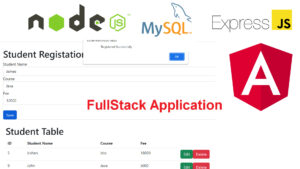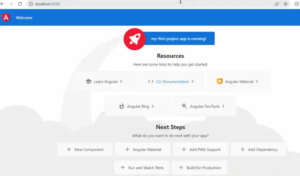This tutorial will teach you how to make Crud Application using Node JS with Angular Frontend application with Mysql Database using Api access Crudapplication.



Create the Node Js Project Type on type command prompt
npm init
and press enter key.after that you have the fill configation of project.after done stuff you
will get the package.json file.
after that you have to install the following dependencies
Express
body-parser
Mysql
you have to create the database and tables in mysql database.
After done the stuff you have to create the file server.js
Server.js
const express = require('express')
const bodyParser = require('body-parser')
const mysql = require("mysql");
const server = express();
server.use(bodyParser.json());
//Establish the database connection
const db = mysql.createConnection({
host: "localhost",
user: "root",
password: "",
database: "dbsmschool",
});
db.connect(function (error) {
if (error) {
console.log("Error Connecting to DB");
} else {
console.log("successfully Connected to DB");
}
});
//Establish the Port
server.listen(8085,function check(error) {
if (error)
{
console.log("Error....dddd!!!!");
}
else
{
console.log("Started....!!!! 8085");
}
});
//Create the Records
server.post("/api/student/add", (req, res) => {
let details = {
stname: req.body.stname,
course: req.body.course,
fee: req.body.fee,
};
let sql = "INSERT INTO student SET ?";
db.query(sql, details, (error) => {
if (error) {
res.send({ status: false, message: "Student created Failed" });
} else {
res.send({ status: true, message: "Student created successfully" });
}
});
});
//view the Records
server.get("/api/student", (req, res) => {
var sql = "SELECT * FROM student";
db.query(sql, function (error, result) {
if (error) {
console.log("Error Connecting to DB");
} else {
res.send({ status: true, data: result });
}
});
});
//Search the Records
server.get("/api/student/:id", (req, res) => {
var studentid = req.params.id;
var sql = "SELECT * FROM student WHERE id=" + studentid;
db.query(sql, function (error, result) {
if (error) {
console.log("Error Connecting to DB");
} else {
res.send({ status: true, data: result });
}
});
});
//Update the Records
server.put("/api/student/update/:id", (req, res) => {
let sql =
"UPDATE student SET stname='" +
req.body.stname +
"', course='" +
req.body.course +
"',fee='" +
req.body.fee +
"' WHERE id=" +
req.params.id;
let a = db.query(sql, (error, result) => {
if (error) {
res.send({ status: false, message: "Student Updated Failed" });
} else {
res.send({ status: true, message: "Student Updated successfully" });
}
});
});
//Delete the Records
server.delete("/api/student/delete/:id", (req, res) => {
let sql = "DELETE FROM student WHERE id=" + req.params.id + "";
let query = db.query(sql, (error) => {
if (error) {
res.send({ status: false, message: "Student Deleted Failed" });
} else {
res.send({ status: true, message: "Student Deleted successfully" });
}
});
});
Angular
Angular
Angular is a front-end application we have already created the folder front end inside the folder open the command prompt and type the commands.
Installing Angular CLI
npm install -g @angular/cli
After that create the new Project of Angular running by the following command
ng new frond-end
Select the SCSS Style for the Advanced CSS and Press Enter Key.
After complete the installation then run the project using following command.
ng serve
it will generate the url link to run the angular application.paste the url in to the browser



Now you see the Angular Welcome Page.
After that open the Angular project into VS code editor.
now you can see the following file structure
Creating a new Component Student Crud
ng g c studentCrud
After that install the Bootstrap by typing the following command
npm i bootstrap
After installed you have to set the path in to style.scss file
@import "~bootstrap/dist/css/bootstrap.css";
app.module.ts
FormModule
HttpClientModule
import { NgModule } from '@angular/core';
import { FormsModule } from '@angular/forms';
import { BrowserModule } from '@angular/platform-browser';
import { AppRoutingModule } from './app-routing.module';
import { AppComponent } from './app.component';
import { CustomerComponent } from './customer/customer.component';
import { HttpClientModule } from '@angular/common/http';
@NgModule({
declarations: [
AppComponent,
CustomerComponent
],
imports: [
BrowserModule,
AppRoutingModule,
FormsModule,
HttpClientModule
],
providers: [],
bootstrap: [AppComponent]
})
export class AppModule { }add these module into the app.module.ts file then only we will manage the forms and Http requests
studentCrud.compoent.html
<div class="container mt-4" >
<div class="card">
<h1>Student Registation</h1>
<form>
<div class="form-group">
<label>Student Name</label>
<input type="text" [(ngModel)]="stname" [ngModelOptions]="{standalone: true}" class="form-control" id="stname" placeholder="Enter Name">
</div>
<div class="form-group">
<label>Course</label>
<input type="text" [(ngModel)]="course" [ngModelOptions]="{standalone: true}" class="form-control" id="course" placeholder="Enter Name">
</div>
<div class="form-group">
<label>Fee</label>
<input type="text" [(ngModel)]="fee" [ngModelOptions]="{standalone: true}" class="form-control" id="fee" placeholder="Enter Fee">
</div>
<button type="submit" class="btn btn-primary mt-4" (click)="save()" >Save</button>
</form>
</div>
<div class="container mt-4" >
<h1>Student Table</h1>
<table class="table">
<thead>
<h1 *ngIf="!isResultLoaded">Loading.................</h1>
<tr>
<th scope="col">ID</th>
<th scope="col">Student Name</th>
<th scope="col">Course</th>
<th scope="col">Fee</th>
</tr>
</thead>
<tbody>
<tr *ngFor="let StudentItem of StudentArray">
<td>{{StudentItem.id }}</td>
<td>{{StudentItem.stname }}</td>
<td>{{StudentItem.course }}</td>
<td>{{StudentItem.fee }}</td>
<td>
<button type="button" class="btn btn-success" (click)="setUpdate(StudentItem)">Edit</button>
<button type="button" class="btn btn-danger" (click)="setDelete(StudentItem)">Delete</button>
</td>
</tr>
</tbody>
</table>
</div>studentCrud.compoent.ts
import { HttpClient } from '@angular/common/http';
import { Component } from '@angular/core';
@Component({
selector: 'app-studencrud',
templateUrl: './studencrud.component.html',
styleUrls: ['./studencrud.component.scss']
})
export class StudencrudComponent {
StudentArray : any[] = [];
isResultLoaded = false;
isUpdateFormActive = false;
stname: string ="";
course: string ="";
fee: string ="";
currentStudentID = "";
constructor(private http: HttpClient )
{
this.getAllStudent();
}
ngOnInit(): void {
}
getAllStudent()
{
this.http.get("http://localhost:9002/api/student/")
.subscribe((resultData: any)=>
{
this.isResultLoaded = true;
console.log(resultData.data);
this.StudentArray = resultData.data;
});
}
register()
{
// this.isLogin = false;
// alert("hi");
let bodyData = {
"stname" : this.stname,
"course" : this.course,
"fee" : this.fee,
};
this.http.post("http://localhost:9002/api/student/add",bodyData).subscribe((resultData: any)=>
{
console.log(resultData);
alert("Employee Registered Successfully")
this.getAllStudent();
// this.name = '';
// this.address = '';
// this.mobile = 0;
});
}
setUpdate(data: any)
{
this.stname = data.stname;
this.course = data.course;
this.fee = data.fee;
this.currentStudentID = data.id;
}
UpdateRecords()
{
let bodyData =
{
"stname" : this.stname,
"course" : this.course,
"fee" : this.fee
};
this.http.put("http://localhost:9002/api/student/update"+ "/"+ this.currentStudentID,bodyData).subscribe((resultData: any)=>
{
console.log(resultData);
alert("Student Registered Updateddd")
this.getAllStudent();
});
}
save()
{
if(this.currentStudentID == '')
{
this.register();
}
else
{
this.UpdateRecords();
}
}
setDelete(data: any)
{
this.http.delete("http://localhost:9002/api/student/delete"+ "/"+ data.id).subscribe((resultData: any)=>
{
console.log(resultData);
alert("Student Deletedddd")
this.getAllStudent();
});
}
}